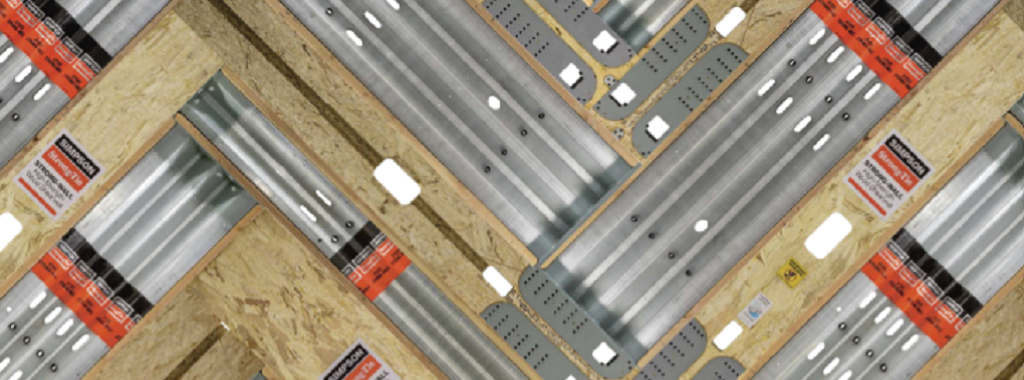While the contents of this blog are certainly not what Abraham Lincoln had in mind when he made the statement that I’m using to title this blog post, it does speak volumes to the pertinence of what will be discussed today. “Design by others” or some variation of this appears in many parts of Simpson Strong-Tie details.
Simpson Strong-Tie receives technical calls from contractors and plans examiners inquiring about information that requires input from the Designer. When these calls occur during construction there can be confusion and frustration in the field because the Designer is needed to evaluate and resolve the issue. Designers and engineers that identify these conditions ahead of time will reduce confusion and delays on their projects.
What are Strong-Wall® Shearwalls?
The Strong-Wall® shearwall product line uses several iterations of “design by others” within its installation details. It is important to note that many details within the installation drawings may require input from the Designer when certain conditions exist.
How do you install the Strong-Wall® Shearwalls?
For example, Detail 7 on SSW2 shows an alternate first-story installation where the Steel Strong-Wall shearwall bypasses the floor framing and bears directly onto concrete. A ledger may be attached to the shearwall to support perpendicular floor framing. The specification of the hanger and attachment is project specific and would require evaluation by the Designer.
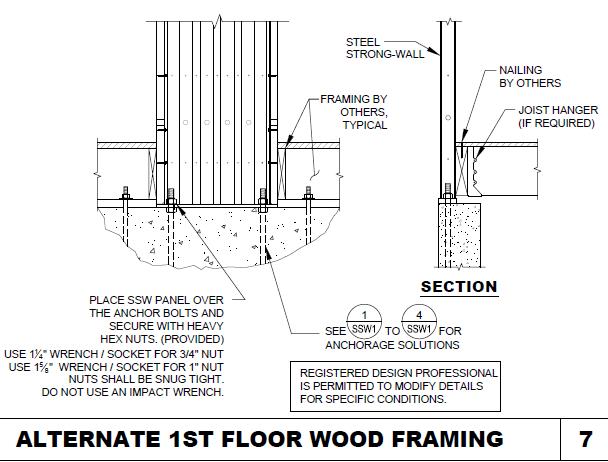
This condition is also on the Strong-Wall SB shearwall installation details as seen in the following detail. The detail is generic and requires attachment information from the Designer. When these conditions do not exist on the project, it may be beneficial to cross out the detail or delete and state “not used” to lessen confusion during plan check and construction.
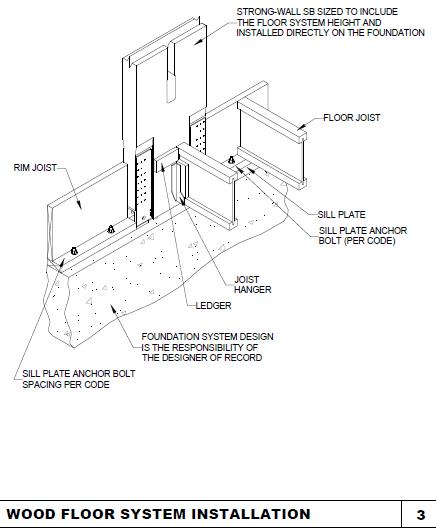
The note “Foundation Dimensions are for Anchorage only. Foundation design (size and reinforcement) by others” can be found in multiple locations on the Wood Strong-Wall, Steel Strong-Wall and Strong-Wall Shear Brace detail sheets.

Soil type and loading conditions not related to the product design vary from project to project and cannot be designed into a one-size-fits-all foundation solution. Thus, the information provided by Simpson Strong-Tie in the installation drawings only addresses the concrete anchorage requirements of ACI 318 (Section D5.2.9/ACI 318-11; Section 17.4.2.9/ACI318-14). These details assume no reinforcement in the footing, resulting in rather large foundations. Since design requirements vary with every project, it’s important for Designers to evaluate and verify each condition.
What are the benefits of the new Steel Strong-Wall Shearwall?
The new Steel Strong-Wall shearwall grade beam solutions reduce the size of the footings required for anchorage. However, the Designer must specify the grade beam reinforcement for proper performance. The details for the grade beam solutions (see SSW1.1 sheet) are based on ACI 318 and testing that was conducted by Simpson Strong-Tie.
For the grade beam solutions, Designers have two options:
(1) Design grade beam to resist the moment induced from amplified forces to the anchor, or
(2) The lesser of the tabulated moment or the amplified LRFD design moment for seismic (ASD Shear / 0.7) x Ω0 x (SSW Height).
Furthermore, the Designer is responsible for specifying the size and number of shear and flexural reinforcement throughout the grade beam beyond the anchor reinforcement depicted in the details.
Delivery of forces to the Strong-Wall shearwall (to the top of wall), including properly sizing the structural members, should be based on project specific requirements.
What are Strong Frame® Moment Frames?
Simpson Strong-Tie Strong Frame® ordinary moment frames and special moment frames contain similar requirements for the Designer. Moment frames have been discussed many times in this blog: Special Moment Frame Installation: What Structural Engineers Should Watch For, Steel Moment Frame Beam Bracing and Breaking News: Simpson Strong-Tie Strong Frame Special Moment Frame Testing Today.
The notes on SMF2 state “Footing/Grade beam size and reinforcing shall be specified by the Designer as required to resist the imposed loads, such as foundation shear and bending, soil bearing pressure, shear transfer, and frame stability/overturning.”
Moment frame foundation solutions are based on satisfying the minimum concrete anchorage requirements. Detailing can be a crucial area for this product line as it is common to find deeper footings at these locations, which should be reflected on your construction documents.
Like Strong Wall shearwalls, Designers must evaluate the project conditions and detail the load path of the forces to the resisting element (in this case the Strong Frame moment frame). Ensuring proper transfer of forces that are detailed within your construction documents will reduce headaches down the road.
What are the Strong-RodTM Systems?
Strong-Rod™ systems are continuous rod tiedown solutions for multi-story, light-frame wood construction. These systems include Anchor Tiedown Systems (ATS) for shearwall overturning restraint and Uplift Restraint Systems (URS) for roofs. Both systems utilize the same components (i.e. bearing plates, rods, couplers and shrinkage compensation devices), however the detailing, design and locations of these two systems differs.
For ATS, the Designer is responsible for the following:
- Developing the cumulative tension/compression loads,
- Determining the system displacement requirements as defined in ICC-ES Acceptance Criteria AC316 to satisfy code required drift equations (this specifically addresses the holdown part of the Equation 4.3-1 of the 2015 Special Design Provisions for Wind and Seismic)
- The location of each holdown/shearwall.
A more elaborate description of the Designer’s responsibilities for ATS can be found on page 23 of our Strong-Rod Systems design guide (F-L-SRS15). Simpson Strong-Tie incorporates this information into our design of the system and provides calculations and installation drawings to the Designer for review (a sample two-story run is shown below).
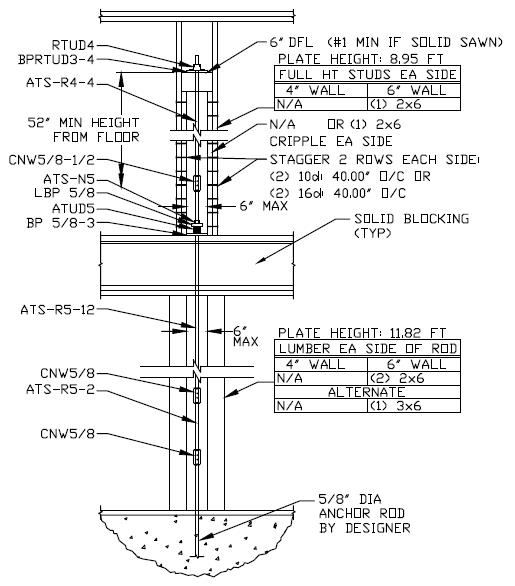
For URS, there are two different approaches to design that have different level of responsibilities. The Designer has fewer responsibilities when specifying a rod with a “system (CRTS)” evaluation report per AC391, but they are still responsible for developing the project’s wind uplift loads, specifying URS details and designing systems for shearwall overturning.
More requirements must be taken into account when designing and specifying a rod system using steel components with a “rod-run only (CRTR)” AC391 evaluation report, or no report at all. (A more elaborate description of the Designer’s responsibilities for URS can be found on page 43 of the Strong-Rod Systems design guide).
Based on the project information provided, the rod manufacturer will design and detail the system and submit calculations and installation drawings to the Designer for review.
What is a Podium Deck Anchorage?
The newest details published by Simpson Strong-Tie on podium deck anchorage solutions were developed to reduce the impact of an industry-wide challenge; resolving large tension forces (upwards of 50 kips) from four- to five-story narrow shearwalls into thin (often 10-14 inch thick) concrete podium decks. These solutions (e.g., design tables installation drawings and sample calculations), which are on our website, rely on special anchor reinforcement details using standard construction rebar.
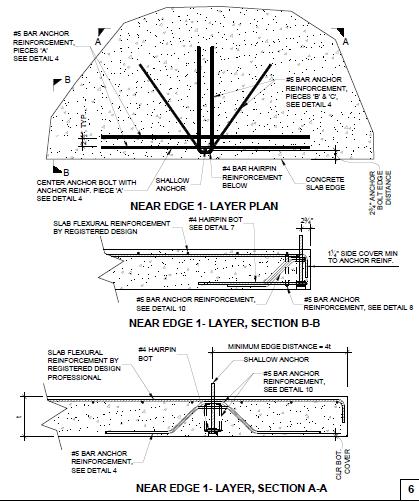
More information about these solutions can be found this blog post and in the shallow anchor page on our website. It is important to note that the Designer is responsible for selecting the best anchorage detail to satisfy the demand loads based on his/her concrete specification and specific project conditions. The Designer is also responsible for designing and detailing the flexural reinforcement within the slab to achieve the amplified forces.
Summary
Adding standard installation details to your construction documents saves significant design time. However, the responsibility does not end with the copy-and-paste. The installation details by Simpson Strong-Tie contain details of many common applications. Some may not apply to your project, while others may require additional input from you. Of course, the Designer is permitted to use alternate details and is not limited to what is shown on the installation drawings. Providing complete information will save time and frustration during plan check and construction. Simpson Strong-Tie is here to answer questions and help with your next project. Please reach out to us by calling 800-999-5099 or by clicking here.



